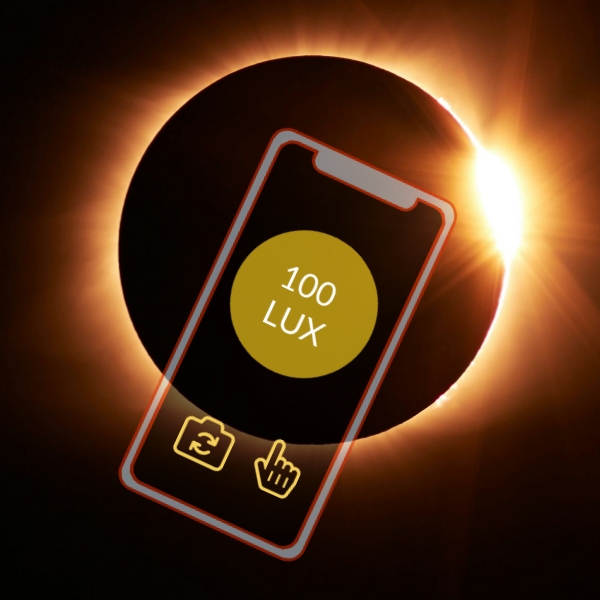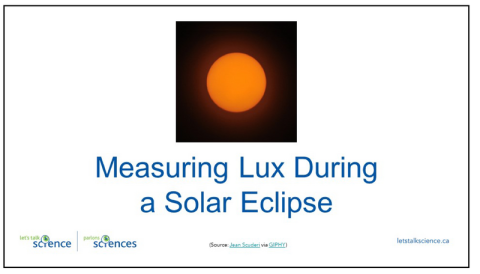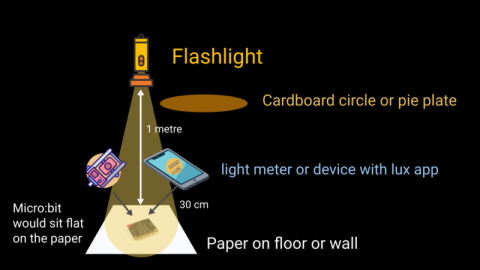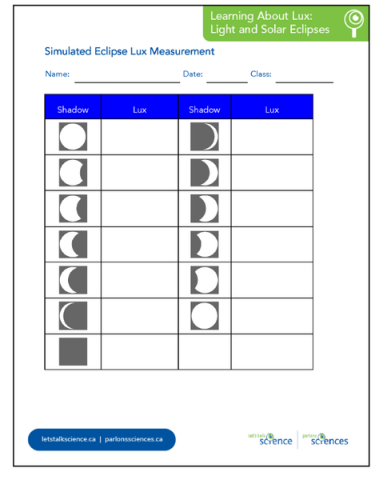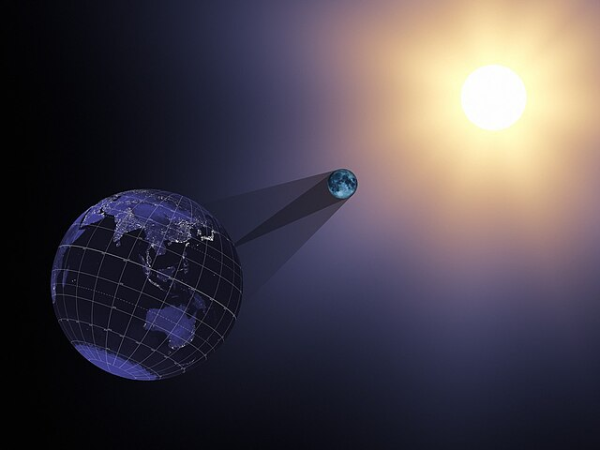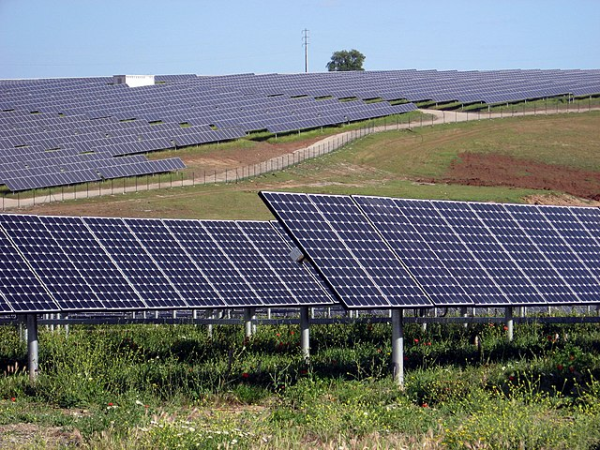Students will:
- Understand how and why light levels vary during a solar eclipse
- Understand how to mathematically represent light levels during a solar eclipse
Learning Goals
Students will:
- Understand how and why light levels vary during a solar eclipse
- Understand how to mathematically represent light levels during a solar eclipse
Students can:
- Correctly explain how and why light levels vary during different phases of a solar eclipse
- Utilize appropriate mathematical models to accurately represent the variation in light levels during a solar eclipse
Success Criteria
Students can:
- Correctly explain how and why light levels vary during different phases of a solar eclipse
- Utilize appropriate mathematical models to accurately represent the variation in light levels during a solar eclipse
This icon indicates potential assessment opportunities.
Observations
- Observe and record anecdotally students’ responses to questions asked about solar eclipses (Minds-on).
- Observe and record anecdotally students’ participation during lux measurement (Action).
Conversations
- Have conversations with students about solar eclipses and lux measurements (Action).
Products
- Students could submit their graphs (Action).
- Students could complete and submit the Lux Measurement reproducibles (Action).
Evidence of Student Learning
This icon indicates potential assessment opportunities.
Observations
- Observe and record anecdotally students’ responses to questions asked about solar eclipses (Minds-on).
- Observe and record anecdotally students’ participation during lux measurement (Action).
Conversations
- Have conversations with students about solar eclipses and lux measurements (Action).
Products
- Students could submit their graphs (Action).
- Students could complete and submit the Lux Measurement reproducibles (Action).
Students will:
- Understand how and why light levels vary during a solar eclipse
- Understand how to mathematically represent light levels during a solar eclipse
Learning Goals
Students will:
- Understand how and why light levels vary during a solar eclipse
- Understand how to mathematically represent light levels during a solar eclipse
Students can:
- Correctly explain how and why light levels vary during different phases of a solar eclipse
- Utilize appropriate mathematical models to accurately represent the variation in light levels during a solar eclipse
Success Criteria
Students can:
- Correctly explain how and why light levels vary during different phases of a solar eclipse
- Utilize appropriate mathematical models to accurately represent the variation in light levels during a solar eclipse
This icon indicates potential assessment opportunities.
Observations
- Observe and record anecdotally students’ responses to questions asked about solar eclipses (Minds-on).
- Observe and record anecdotally students’ participation during lux measurement (Action).
Conversations
- Have conversations with students about solar eclipses and lux measurements (Action).
Products
- Students could submit their graphs (Action).
- Students could complete and submit the Lux Measurement reproducibles (Action).
Evidence of Student Learning
This icon indicates potential assessment opportunities.
Observations
- Observe and record anecdotally students’ responses to questions asked about solar eclipses (Minds-on).
- Observe and record anecdotally students’ participation during lux measurement (Action).
Conversations
- Have conversations with students about solar eclipses and lux measurements (Action).
Products
- Students could submit their graphs (Action).
- Students could complete and submit the Lux Measurement reproducibles (Action).
Materials and Preparation
| Material/Technology/Setting | Quantity |
|---|---|
|
For teacher use |
|
Action #1 - Simulated Eclipse Time permitting this action could be used for practice before measuring the eclipse in real time.
|
1 set per group (or one set if doing as a whole class demonstration) |
|
Action #2 - Real Time Eclipse
|
1 set per group (or one set if doing as a whole class demonstration) |
|
1 per student |
Materials
| Material/Technology/Setting | Quantity |
|---|---|
|
For teacher use |
|
Action #1 - Simulated Eclipse Time permitting this action could be used for practice before measuring the eclipse in real time.
|
1 set per group (or one set if doing as a whole class demonstration) |
|
Action #2 - Real Time Eclipse
|
1 set per group (or one set if doing as a whole class demonstration) |
|
1 per student |
- Important Note: In the activity section of the lesson plan, there are two actions. The first action involves observing and measuring the solar eclipse in real time. This action is only applicable if you are within the path of the solar eclipse. You can find your jurisdiction on this website to determine whether or not you are within that zone. The second action provides you with the ability to simulate a solar eclipse in the classroom.
- Determine what kind of lux measuring device students will be using. This could be a micro:bit coded to be a light sensor, a commercial light meter used for photography or a lux measurement app on a phone. Lux measurement apps are readily available and free on Apple and Android app stores. If students are going to use an app, choose one in advance so students are all using the same app. Have students download it prior to the lesson.
- If you are in the path of the eclipse, and have time, you may want to do both the simulated eclipse measuring (as practice) and the real time eclipse measuring (putting the practice to the test).
Preparation
- Important Note: In the activity section of the lesson plan, there are two actions. The first action involves observing and measuring the solar eclipse in real time. This action is only applicable if you are within the path of the solar eclipse. You can find your jurisdiction on this website to determine whether or not you are within that zone. The second action provides you with the ability to simulate a solar eclipse in the classroom.
- Determine what kind of lux measuring device students will be using. This could be a micro:bit coded to be a light sensor, a commercial light meter used for photography or a lux measurement app on a phone. Lux measurement apps are readily available and free on Apple and Android app stores. If students are going to use an app, choose one in advance so students are all using the same app. Have students download it prior to the lesson.
- If you are in the path of the eclipse, and have time, you may want to do both the simulated eclipse measuring (as practice) and the real time eclipse measuring (putting the practice to the test).
- Students have a basic understanding of what an eclipse is and why it occurs. You may want to do a lesson such as the one in the 3 Part Math Task - Modeling a Total Solar Eclipse prior to this lesson.
- Students have a basic understanding of the solar system including which bodies emit and reflect light
- Students understand the concepts of light and shadow including that light travels in a straight path and that light can be absorbed, reflected, and refracted.
Student Prior Knowledge and Skills
- Students have a basic understanding of what an eclipse is and why it occurs. You may want to do a lesson such as the one in the 3 Part Math Task - Modeling a Total Solar Eclipse prior to this lesson.
- Students have a basic understanding of the solar system including which bodies emit and reflect light
- Students understand the concepts of light and shadow including that light travels in a straight path and that light can be absorbed, reflected, and refracted.
| Material/Technology/Setting | Quantity |
|---|---|
|
For teacher use |
|
Action #1 - Simulated Eclipse Time permitting this action could be used for practice before measuring the eclipse in real time.
|
1 set per group (or one set if doing as a whole class demonstration) |
|
Action #2 - Real Time Eclipse
|
1 set per group (or one set if doing as a whole class demonstration) |
|
1 per student |
Materials
| Material/Technology/Setting | Quantity |
|---|---|
|
For teacher use |
|
Action #1 - Simulated Eclipse Time permitting this action could be used for practice before measuring the eclipse in real time.
|
1 set per group (or one set if doing as a whole class demonstration) |
|
Action #2 - Real Time Eclipse
|
1 set per group (or one set if doing as a whole class demonstration) |
|
1 per student |
- Important Note: In the activity section of the lesson plan, there are two actions. The first action involves observing and measuring the solar eclipse in real time. This action is only applicable if you are within the path of the solar eclipse. You can find your jurisdiction on this website to determine whether or not you are within that zone. The second action provides you with the ability to simulate a solar eclipse in the classroom.
- Determine what kind of lux measuring device students will be using. This could be a micro:bit coded to be a light sensor, a commercial light meter used for photography or a lux measurement app on a phone. Lux measurement apps are readily available and free on Apple and Android app stores. If students are going to use an app, choose one in advance so students are all using the same app. Have students download it prior to the lesson.
- If you are in the path of the eclipse, and have time, you may want to do both the simulated eclipse measuring (as practice) and the real time eclipse measuring (putting the practice to the test).
Preparation
- Important Note: In the activity section of the lesson plan, there are two actions. The first action involves observing and measuring the solar eclipse in real time. This action is only applicable if you are within the path of the solar eclipse. You can find your jurisdiction on this website to determine whether or not you are within that zone. The second action provides you with the ability to simulate a solar eclipse in the classroom.
- Determine what kind of lux measuring device students will be using. This could be a micro:bit coded to be a light sensor, a commercial light meter used for photography or a lux measurement app on a phone. Lux measurement apps are readily available and free on Apple and Android app stores. If students are going to use an app, choose one in advance so students are all using the same app. Have students download it prior to the lesson.
- If you are in the path of the eclipse, and have time, you may want to do both the simulated eclipse measuring (as practice) and the real time eclipse measuring (putting the practice to the test).
- Students have a basic understanding of what an eclipse is and why it occurs. You may want to do a lesson such as the one in the 3 Part Math Task - Modeling a Total Solar Eclipse prior to this lesson.
- Students have a basic understanding of the solar system including which bodies emit and reflect light
- Students understand the concepts of light and shadow including that light travels in a straight path and that light can be absorbed, reflected, and refracted.
Student Prior Knowledge and Skills
- Students have a basic understanding of what an eclipse is and why it occurs. You may want to do a lesson such as the one in the 3 Part Math Task - Modeling a Total Solar Eclipse prior to this lesson.
- Students have a basic understanding of the solar system including which bodies emit and reflect light
- Students understand the concepts of light and shadow including that light travels in a straight path and that light can be absorbed, reflected, and refracted.
Teaching and Learning Activities
This icon indicates potential assessment opportunities.
Minds-On: What Is a Solar Eclipse [10-15 min.]
| Instructions | Teaching Tips |
|---|---|
| Begin with a classroom discussion to find out what students already know about solar eclipses. Refer to the teaching tips for discussion prompts. If your students need a more guided approach to generate ideas, refer to the teaching tips to incorporate a learning strategy. |
DiscussionsDiscussion prompts can include:
IdeaYou could have students fill out a KWL Chart or participate in a Think-Pair-Share activity. This will also encourage collaborative participation. |
|
Show students the video Solar Eclipse 101 from National Geographic. Ask students to share any new knowledge gained from the video. If students fill out a KWL Chart, you could collect it for assessment. |
Images and VideosTurn on closed captioning. |
Action: Measuring an Eclipse [45 min.]
| Instructions | Teaching Tips |
|---|---|
|
Show students the slideshow Measuring lux during a solar eclipse [Google slides] [pptx] |
|
|
Assign students to groups of two. Make sure each group has a lux measuring device. This could be a coded micro:bit, light meter or lux meter apps on a phone or tablet. They will also need a sheet of white paper. Have students practice taking lux measurements in different places around the classroom or school by putting the sheet of paper in a location and taking lux measurements. Proceed through Action #1 or Action #2 according to what works for your classroom. |
IdeaAn alternative to a lux measurement app you can follow this light intensity meter guide to gather lux measurements. Or, if your school has a photography class or club, you can inquire about obtaining a hand-held light metre. |
Action #1 - Simulated EclipseAssign students to groups of four to five. Five works best. They will have following tasks:
The materials will be set up as in the diagram below. The piece of paper can either go on the floor or be taped onto a wall. The flashlight should be approximately 1 metre away from the paper. The light meter or device with the lux app will need to be held slightly off to side and approximately 30 cm away from the paper. It should be pointing at the brightest part of the paper. If using a micro:bit, it will need to be flush against the paper. This may mean flat on the floor, or taped to the paper. Image - Text VersionShown is a colour diagram of a flashlight shining down onto a piece of paper, with other objects nearby. The flashlight floats at the top of the diagram, against a black background. A cone of yellow light extends from it, down to a white square at the bottom. This is labelled “Paper on floor or wall.” The distance between the flashlight and the paper is labelled “1 metre.” A brown circle floats just below and to the right of the flashlight. This is labelled “Cardboard circle or pie plate.” Below, two different rectangular devices float, one on each side of the lightbeam. These are labelled “light meter or device with lux app.” Arrows point from these devices, down to the paper. A dark grey rectangle sits in the centre of the paper. This is labelled “Micro:bit would sit flat on the paper.” Gif of simulated eclipse (©2024 Let’s Talk Science). Provide students with the Simulated Eclipse Lux Measurement reproducible [Google doc] [Word doc] [PDF]. Have them complete the chart on the first page by reproducing each shadow and measuring the lux. Afterwards have students create a graph using their lux measurements. Action #2 - Real Time Eclipse ViewingHave students set up their solar eclipse station by taking the solar altitude angle into consideration. Students should determine the angle required to tilt the front screen of the mobile device so that it aligns perpendicularly to the Sun's rays. It's important to recognize that the provided solar altitude angle denotes the angle at which the Sun's rays meet Earth at the specified location. Image - Text VersionShown is a colour diagram of the Sun shining down onto an object on a table. In the top left corner is a yellow circle labelled “The Sun.” A straight yellow line extends from this, diagonally down to a brown stripe along the bottom, labelled “Horizon.” The angle between the yellow line and the horizon is labelled “Solar altitude angle.” A diagonal white line intersects the yellow one. The angle between the two is labelled “Right angle.” A black table sits on the horizon, just below this intersection. It holds a triangular brown object labelled “Stand,” and a rectangular grey object labelled “Light measuring device.” The light measuring device sits along the right angle line, where it intersects with the light from the Sun. Students may need to construct some sort of stand to hold the light-measuring device at the correct angle. Assign students to groups of two to three. They will have the following tasks:
Have students use the lux measurement apps to record lux values during the solar eclipse on the Eclipse Lux Measurement reproducible [Google doc] [Word doc] [PDF]. |
IdeaIf the classroom is too dark for writing, you could have students use the flashlight function on their phones to illuminate their worksheets as long as they are not close to the lux meters. IdeaMisconception Alert! Lumen and lux are not the same thing! You could have students watch the video How to distinguish Lumen, Lux and Candela to understand the difference between these measurements of light. |
|
After students have collected their data, have them construct graphs of the data. Have students tell you:
The graphs could be created on graph paper or using spreadsheet software like Microsoft Excel or Google Sheets. Ask students what they notice about the shape of the line on their graphs. You could collect student graphs to see how accurately they represented the data in a graphic format. |
IdeaYou could use a web-based program to create graphs like this page from NCES Kids' Zone or this page from Solumaths. |
Consolidation: Applications in the Real-World [20-25 min.]
| Instructions | Teaching Tips |
|---|---|
|
Individually or in pairs, have students read light pollution backgrounder. Visit the Starting Points at the bottom of the document to find ways to use this backgrounder in your lesson.
You could ask students about some real-world applications of lux measurement discussed in the article. You may wish to have students complete the Real-World Lux Measuring reproducible [Google doc] [Word doc] [PDF] which explores some of the topics from the light pollution backgrounder. You could collect the worksheet for assessment. |
IdeaStudents could dig deeper into the use of lux measurements in different fields such as physics, astronomy and engineering. |
| You could end the lesson by asking students to share some of their answers from the worksheet. Or you could have a reflective discussion with students using the discussion prompts. |
DiscussionsDiscussion prompts can include:
|
Background Information for Teachers
Measuring Lux
Measuring lux during a solar eclipse is important in understanding the changes that happen on Earth when the Moon passes between the Earth and the Sun. Lux measurements offer us information about the amount of light that reaches the Earth during different stages of the eclipse.
Image - Text Version
Shown is a colour illustration of the Moon casting a shadow across the Earth. The Sun is shown as a large, brightly glowing white sphere in the top right corner, with dark blue space around. The Moon is a smaller, mottled bluish-grey sphere about halfway between the Sun and Earth. Earth is the largest sphere. It is marked with lines of latitude and longitude. The visible side of the globe is dark blue, sprinkled with the lights of cities on the continents. Two shadows extend from the Moon to the surface of Earth. One is lighter and becomes wider as it gets to Earth. The other is darker, in the centre of the lighter one. It narrows between the Moon and Earth.
Lux measurement also provides us with data that we can use to understand its applications in the real-world. This includes how to optimize solar technologies as well as how light pollution impacts living things. Understanding lux not only helps us to understand solar eclipses but also how to improve life on Earth!
Image - Text Version
Shown is a colour photograph of many long rows of flat solar panels, angled up to the sky. Two rows are large and in focus in the foreground. Each panel is rectangular and dark blue, with a silver grid pattern. They are connected into long rows, mounted on grey metal legs surrounded by grass and shrubs. In the background, many more rows of panels stretch across a hill to the horizon. The sky above is blue and cloudless.
Additional Resources
Reproducibles
- Measuring lux during a solar eclipse slideshow [Google slides] [pptx]
- Simulated Eclipse Lux Measurement reproducible [Google doc] [Word doc] [PDF]
- Eclipse Lux Measurement reproducible [Google doc] [Word doc] [PDF]
- Real-World Lux Measuring reproducible [Google doc] [Word doc] [PDF]
Videos
Reproducibles and Media
Reproducibles
- Measuring lux during a solar eclipse slideshow [Google slides] [pptx]
- Simulated Eclipse Lux Measurement reproducible [Google doc] [Word doc] [PDF]
- Eclipse Lux Measurement reproducible [Google doc] [Word doc] [PDF]
- Real-World Lux Measuring reproducible [Google doc] [Word doc] [PDF]
Videos
Science
- Students could add drawings of the Sun as seen through a pinhole viewer to their data sheets.
- Students could explore the difference between lux, lumens, candelas and other related light measurements.
- Students could try using a lux meter with different colours of paper, different textures of materials (e.g., fabric, glass, mirrors, etc.) and relate back to the property of reflection.
Mathematical Thinking
- Students could compare their graphs to line graphs measuring lux found online for previous eclipses.
Computational Thinking
- Students could try some of the other coding ideas that use the light diodes on the micro:bit.
Indigenous Perspectives
- Indigenous Perspectives on Solar Eclipses
In this video (6:45 min.), Dr. Laurie Rousseau-Nepton a Canadian astronomer and member of the Mashteuiatsch community shares eclipse stories from around the world. - Cree Constellations Expert Explains Connection Between Eclipse and First Nations | APTN News
In this video, Cree elder Wilfred Buck talks about Cree connections to the sky. - Solar Eclipse: Solomon Ratt, th-dialect – Cree Literacy Network
Here you can find a short poem about an eclipse in English, Cree and Inuit syllabics. - Indigenous Knowledge - Solar Eclipse 2024
In this video (17:22 min.), listen to members from Oneida, Mohawk and Innu communities talk about eclipses. - A.15 Indigenous Astronomy
This resource from BC Campus has a number of resources and links about indigenous astronomy.
Career Education
- Students could explore the career of Solar Physics by learning about the astronomer Shadia Habbal.
- Students could explore careers that require lux measurements. Lighting Ergonomics is crucial in the field of health and safety.
Extensions
Science
- Students could add drawings of the Sun as seen through a pinhole viewer to their data sheets.
- Students could explore the difference between lux, lumens, candelas and other related light measurements.
- Students could try using a lux meter with different colours of paper, different textures of materials (e.g., fabric, glass, mirrors, etc.) and relate back to the property of reflection.
Mathematical Thinking
- Students could compare their graphs to line graphs measuring lux found online for previous eclipses.
Computational Thinking
- Students could try some of the other coding ideas that use the light diodes on the micro:bit.
Indigenous Perspectives
- Indigenous Perspectives on Solar Eclipses
In this video (6:45 min.), Dr. Laurie Rousseau-Nepton a Canadian astronomer and member of the Mashteuiatsch community shares eclipse stories from around the world. - Cree Constellations Expert Explains Connection Between Eclipse and First Nations | APTN News
In this video, Cree elder Wilfred Buck talks about Cree connections to the sky. - Solar Eclipse: Solomon Ratt, th-dialect – Cree Literacy Network
Here you can find a short poem about an eclipse in English, Cree and Inuit syllabics. - Indigenous Knowledge - Solar Eclipse 2024
In this video (17:22 min.), listen to members from Oneida, Mohawk and Innu communities talk about eclipses. - A.15 Indigenous Astronomy
This resource from BC Campus has a number of resources and links about indigenous astronomy.
Career Education
- Students could explore the career of Solar Physics by learning about the astronomer Shadia Habbal.
- Students could explore careers that require lux measurements. Lighting Ergonomics is crucial in the field of health and safety.
David Saint-Jacques invites you to watch the total solar eclipse (2024)
Canadian Space Agency astronaut David Saint-Jacques explains this remarkable celestial event and reminds you to use eye protection as you witness the solar eclipse!
2024 Total Solar Eclipse (2023)
This interactive page from NASA provides key information regarding the 2024 Total Eclipse.
Science with a Smartphone: Measure Light with Lux (2019)
This in-depth guide from Scientific American provides information on measuring lux with your mobile device.
Introducing the Sun (2023)
Learn the basics of the star we call the Sun in this backgrounder by Let’s Talk Science.
How to safely watch a solar eclipse (2024)
This page from the Canadian Space Agency has a video about how to safely watch a solar eclipse as well as links to other eclipse resources.
Light and Its Properties (2022)
Learn more about light and its properties in this backgrounder by Let’s Talk Science.
Learn More
David Saint-Jacques invites you to watch the total solar eclipse (2024)
Canadian Space Agency astronaut David Saint-Jacques explains this remarkable celestial event and reminds you to use eye protection as you witness the solar eclipse!
2024 Total Solar Eclipse (2023)
This interactive page from NASA provides key information regarding the 2024 Total Eclipse.
Science with a Smartphone: Measure Light with Lux (2019)
This in-depth guide from Scientific American provides information on measuring lux with your mobile device.
Introducing the Sun (2023)
Learn the basics of the star we call the Sun in this backgrounder by Let’s Talk Science.
How to safely watch a solar eclipse (2024)
This page from the Canadian Space Agency has a video about how to safely watch a solar eclipse as well as links to other eclipse resources.
Light and Its Properties (2022)
Learn more about light and its properties in this backgrounder by Let’s Talk Science.
Let’s Talk Science. (2020). Light Pollution.
NASA. (2017). Eclipse: How can the little Moon hide the giant Sun?
NASA. (2017). Measuring Solar Energy During an Eclipse.
NASA. (2024). 2024 Total Solar Eclipse.
References
Let’s Talk Science. (2020). Light Pollution.
NASA. (2017). Eclipse: How can the little Moon hide the giant Sun?
NASA. (2017). Measuring Solar Energy During an Eclipse.
NASA. (2024). 2024 Total Solar Eclipse.
Reproducibles
- Measuring lux during a solar eclipse slideshow [Google slides] [pptx]
- Simulated Eclipse Lux Measurement reproducible [Google doc] [Word doc] [PDF]
- Eclipse Lux Measurement reproducible [Google doc] [Word doc] [PDF]
- Real-World Lux Measuring reproducible [Google doc] [Word doc] [PDF]
Videos
Reproducibles and Media
Reproducibles
- Measuring lux during a solar eclipse slideshow [Google slides] [pptx]
- Simulated Eclipse Lux Measurement reproducible [Google doc] [Word doc] [PDF]
- Eclipse Lux Measurement reproducible [Google doc] [Word doc] [PDF]
- Real-World Lux Measuring reproducible [Google doc] [Word doc] [PDF]
Videos
Science
- Students could add drawings of the Sun as seen through a pinhole viewer to their data sheets.
- Students could explore the difference between lux, lumens, candelas and other related light measurements.
- Students could try using a lux meter with different colours of paper, different textures of materials (e.g., fabric, glass, mirrors, etc.) and relate back to the property of reflection.
Mathematical Thinking
- Students could compare their graphs to line graphs measuring lux found online for previous eclipses.
Computational Thinking
- Students could try some of the other coding ideas that use the light diodes on the micro:bit.
Indigenous Perspectives
- Indigenous Perspectives on Solar Eclipses
In this video (6:45 min.), Dr. Laurie Rousseau-Nepton a Canadian astronomer and member of the Mashteuiatsch community shares eclipse stories from around the world. - Cree Constellations Expert Explains Connection Between Eclipse and First Nations | APTN News
In this video, Cree elder Wilfred Buck talks about Cree connections to the sky. - Solar Eclipse: Solomon Ratt, th-dialect – Cree Literacy Network
Here you can find a short poem about an eclipse in English, Cree and Inuit syllabics. - Indigenous Knowledge - Solar Eclipse 2024
In this video (17:22 min.), listen to members from Oneida, Mohawk and Innu communities talk about eclipses. - A.15 Indigenous Astronomy
This resource from BC Campus has a number of resources and links about indigenous astronomy.
Career Education
- Students could explore the career of Solar Physics by learning about the astronomer Shadia Habbal.
- Students could explore careers that require lux measurements. Lighting Ergonomics is crucial in the field of health and safety.
Extensions
Science
- Students could add drawings of the Sun as seen through a pinhole viewer to their data sheets.
- Students could explore the difference between lux, lumens, candelas and other related light measurements.
- Students could try using a lux meter with different colours of paper, different textures of materials (e.g., fabric, glass, mirrors, etc.) and relate back to the property of reflection.
Mathematical Thinking
- Students could compare their graphs to line graphs measuring lux found online for previous eclipses.
Computational Thinking
- Students could try some of the other coding ideas that use the light diodes on the micro:bit.
Indigenous Perspectives
- Indigenous Perspectives on Solar Eclipses
In this video (6:45 min.), Dr. Laurie Rousseau-Nepton a Canadian astronomer and member of the Mashteuiatsch community shares eclipse stories from around the world. - Cree Constellations Expert Explains Connection Between Eclipse and First Nations | APTN News
In this video, Cree elder Wilfred Buck talks about Cree connections to the sky. - Solar Eclipse: Solomon Ratt, th-dialect – Cree Literacy Network
Here you can find a short poem about an eclipse in English, Cree and Inuit syllabics. - Indigenous Knowledge - Solar Eclipse 2024
In this video (17:22 min.), listen to members from Oneida, Mohawk and Innu communities talk about eclipses. - A.15 Indigenous Astronomy
This resource from BC Campus has a number of resources and links about indigenous astronomy.
Career Education
- Students could explore the career of Solar Physics by learning about the astronomer Shadia Habbal.
- Students could explore careers that require lux measurements. Lighting Ergonomics is crucial in the field of health and safety.
David Saint-Jacques invites you to watch the total solar eclipse (2024)
Canadian Space Agency astronaut David Saint-Jacques explains this remarkable celestial event and reminds you to use eye protection as you witness the solar eclipse!
2024 Total Solar Eclipse (2023)
This interactive page from NASA provides key information regarding the 2024 Total Eclipse.
Science with a Smartphone: Measure Light with Lux (2019)
This in-depth guide from Scientific American provides information on measuring lux with your mobile device.
Introducing the Sun (2023)
Learn the basics of the star we call the Sun in this backgrounder by Let’s Talk Science.
How to safely watch a solar eclipse (2024)
This page from the Canadian Space Agency has a video about how to safely watch a solar eclipse as well as links to other eclipse resources.
Light and Its Properties (2022)
Learn more about light and its properties in this backgrounder by Let’s Talk Science.
Learn More
David Saint-Jacques invites you to watch the total solar eclipse (2024)
Canadian Space Agency astronaut David Saint-Jacques explains this remarkable celestial event and reminds you to use eye protection as you witness the solar eclipse!
2024 Total Solar Eclipse (2023)
This interactive page from NASA provides key information regarding the 2024 Total Eclipse.
Science with a Smartphone: Measure Light with Lux (2019)
This in-depth guide from Scientific American provides information on measuring lux with your mobile device.
Introducing the Sun (2023)
Learn the basics of the star we call the Sun in this backgrounder by Let’s Talk Science.
How to safely watch a solar eclipse (2024)
This page from the Canadian Space Agency has a video about how to safely watch a solar eclipse as well as links to other eclipse resources.
Light and Its Properties (2022)
Learn more about light and its properties in this backgrounder by Let’s Talk Science.
Let’s Talk Science. (2020). Light Pollution.
NASA. (2017). Eclipse: How can the little Moon hide the giant Sun?
NASA. (2017). Measuring Solar Energy During an Eclipse.
NASA. (2024). 2024 Total Solar Eclipse.
References
Let’s Talk Science. (2020). Light Pollution.
NASA. (2017). Eclipse: How can the little Moon hide the giant Sun?
NASA. (2017). Measuring Solar Energy During an Eclipse.
NASA. (2024). 2024 Total Solar Eclipse.
